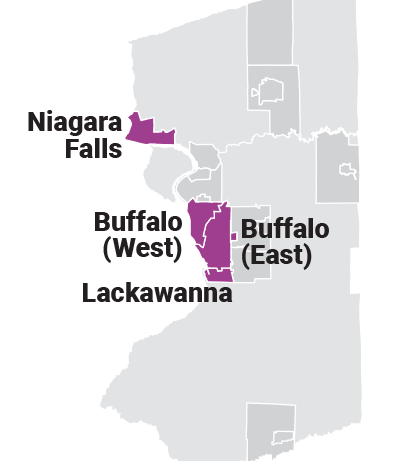Median Home Value, 2017
$149,345

Neighborhoods west of Main Street in the city of Buffalo have made strides in recent years. Poverty rates are down, crime is down, and high school graduation rates are up. Still, almost half of all residents live in or near poverty and vulnerable populations, like refugees and immigrants, young adults, seniors, and families with children are at high risk for poverty.
Click here to learn more about what living in or near poverty means for individuals and families.
Vulnerable populations, % living in poverty, 2017
Source: American Community Survey.
Source: American Community Survey.
Source: American Community Survey.
Source: American Community Survey.
Source: American Community Survey.
Source: American Community Survey.
| Rank | Employer |
|---|---|
| #1 | M&T Bank |
| #2 | Erie County |
| #3 | City of Buffalo |
| #4 | Buffalo City School District |
| #5 | BlueCross BlueShield-Western New York |
| #6 | SUNY Buffalo State |
| #7 | Rich Products Corp. |
| #8 | Buffalo Psychiatric Center |
| #9 | Erie County Sheriffs Department |
| #10 | New Era Cap Co Inc. |
Source: Various. See Data Sources and Notes.
| Buffalo West | Buffalo Niagara | |
|---|---|---|
| Total Jobs | 89,202 | 547,851 |
| Earnings <$15k/yr | 21,681 (24%) | 150,324 (27%) |
| Earnings $15k-$40k/yr | 26,641 (30%) | 178,599 (33%) |
| Earnings >$40k/yr | 40,880 (46%) | 218,928 (40%) |
Source: US Census Bureau, LEHD.
$149,345
$758/mo



Over 200 human service providers and leaders use Numbers in Need to find information, build partnerships, pursue funding and advocate for their community.
“This data has been instrumental in finding what our community looks like and what obstacles we need to tackle to move ahead.”
“I have repeatedly and often share this data with colleagues and community members.”